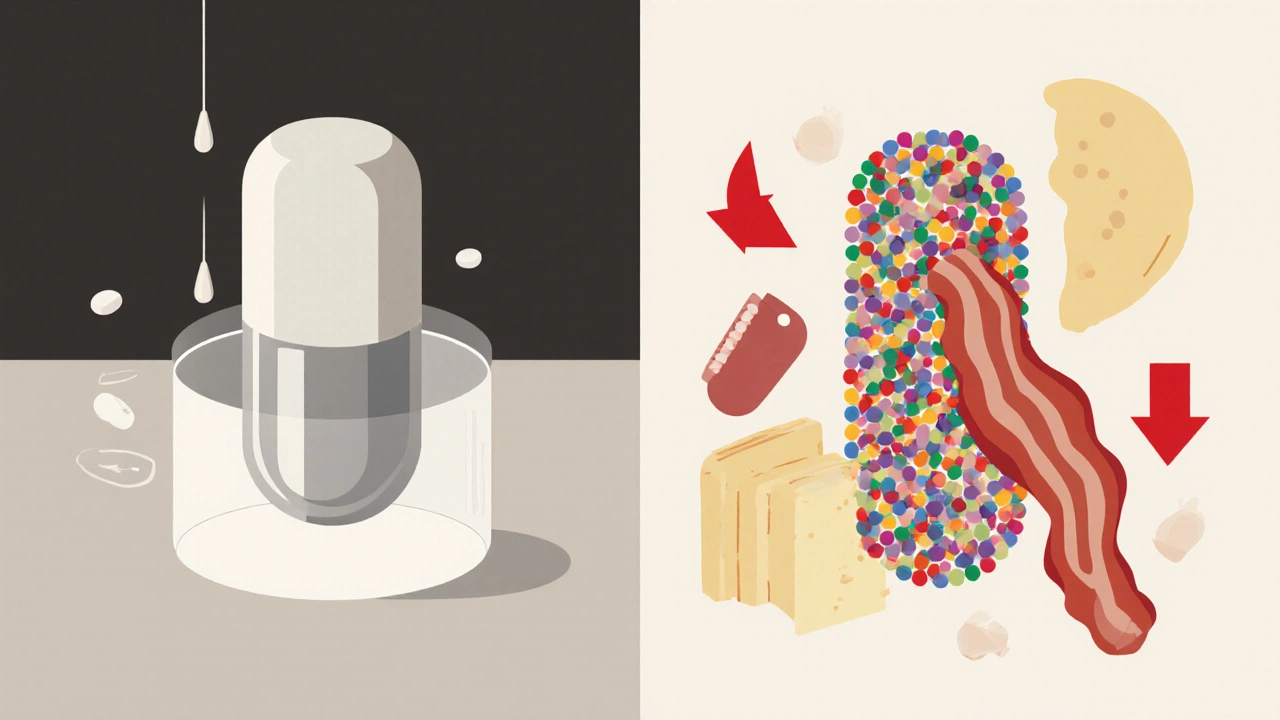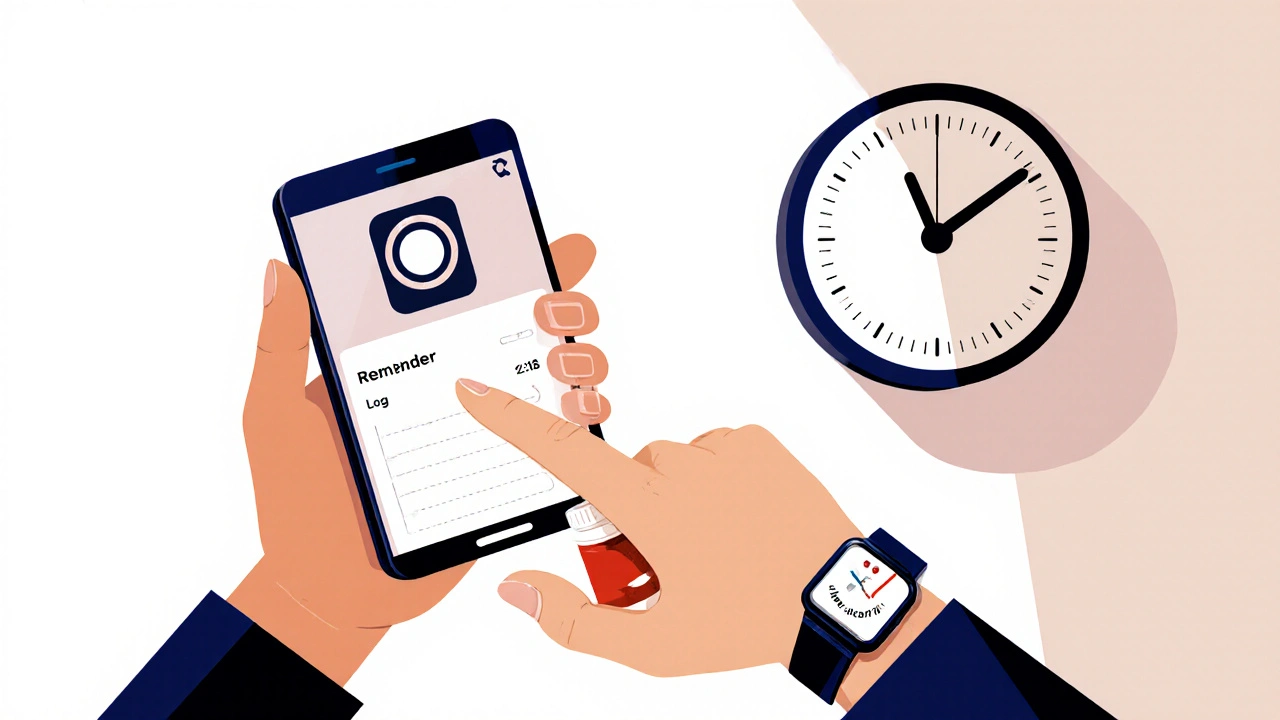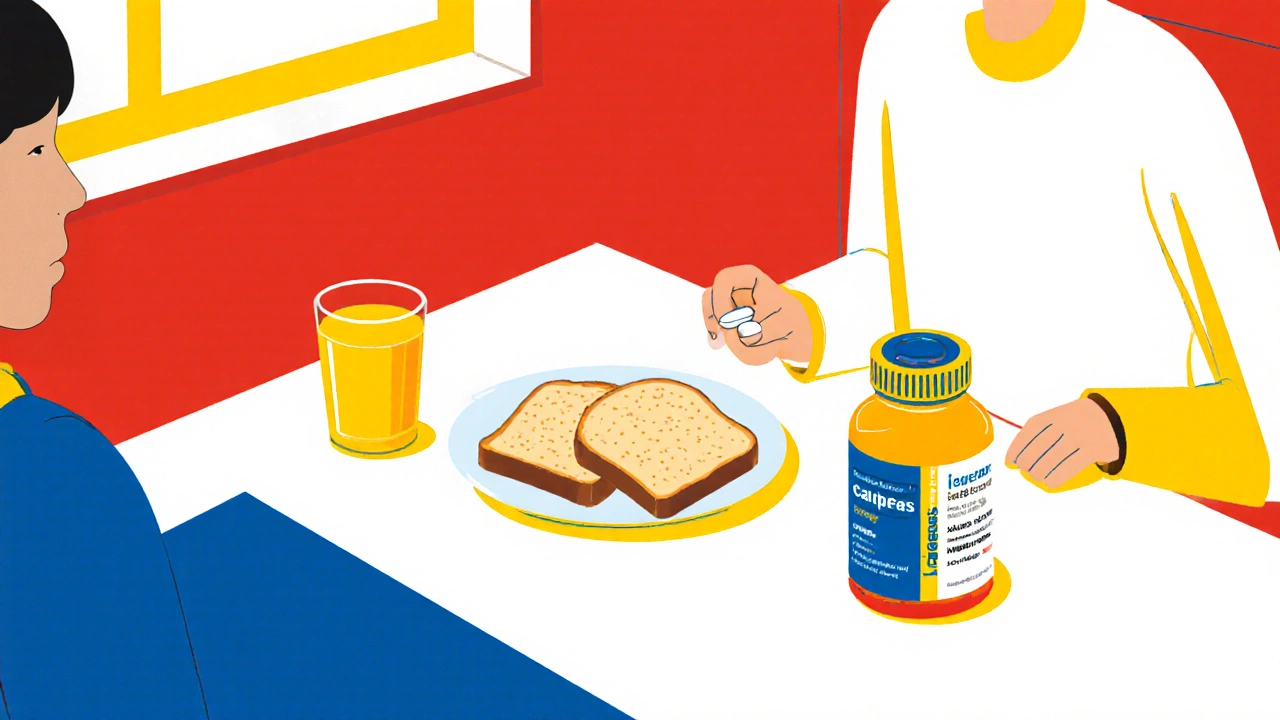Breakfast Timing Calculator for Extended-Release Medications
Medication Information
Results Summary
Select medication type and breakfast to see your personalized recommendation
Select options above to see absorption impact
When you take an extended-release medication a dosage form designed to release the active drug gradually over several hours, the moment you eat breakfast timing can change how well it works. A solid routine-always taking the pill with breakfast or always on an empty stomach-helps keep drug levels steady, reduces surprises, and makes daily life smoother.
Key Takeaways
- Food can cut early exposure of some extended‑release stimulants by up to 40%.
- Osmotic‑controlled OROS technology (e.g., CONCERTA) is largely food‑insensitive, while bead‑based formulations (e.g., ADDERALL XR) lose effectiveness after a high‑fat breakfast.
- Consistent morning habits improve symptom control for ADHD, thyroid, and some cardiovascular drugs.
- Digital reminders and simple symptom logs can lock in the routine.
- Future tools-wearables, pharmacogenomics-will personalize the best timing for each person.
How Food Interacts with Extended‑Release Formulations
Extended‑release pills rely on the gut’s environment to release the drug in a predictable pattern. Two main mechanisms dominate the market:
- Osmotic Release Oral System (OROS): a semi‑permeable membrane lets water in, creating pressure that pushes the drug out at a constant rate. Because the release is driven by osmotic pressure rather than the stomach’s contents, it stays steady whether you eat a bagel or skip breakfast.
- Bead‑based or matrix systems: tiny drug‑filled beads are coated and released as the tablet dissolves. Their dissolution speed can speed up or slow down depending on gastric pH, motility, and the presence of fats.
When a high‑fat meal slows gastric emptying (typically 2-5 hours for solid food), the beads stay longer in the stomach. The fatty matrix can also coat the beads, reducing early absorption. In contrast, the OROS design bypasses those variables, delivering a flat curve of pharmacokinetics regardless of what you ate.
Case Study: ADHD Stimulants - CONCERTA vs. ADDERALL XR
The 2002 Auiler et al. trial compared two popular extended‑release ADHD drugs in 24 healthy volunteers. Participants took either a 36 mg OROS methylphenidate (CONCERTA) or a 20 mg bead‑based amphetamine mix (ADDERALL XR) after a standard high‑fat breakfast (≈ 600 calories of fat) and after an overnight fast.
Results showed a striking split:
- For ADDERALL XR, the partial area under the curve (AUC) for the first 8 hours dropped 30‑40 % when taken with food.
- For CONCERTA, early exposure changed less than 5 %.
Clinically, that meant children who ate breakfast saw a noticeable dip in focus around 10 am on the amphetamine pill, while the methylphenidate pill kept them steady through the school morning.

Practical Tips for a Consistent Morning Routine
Doctors and pharmacists agree that the best approach is not “take it when you remember,” but “pick a rule and stick to it.” Here’s a step‑by‑step cheat sheet you can hand to patients:
- Choose a rule. Either always take the medication with breakfast (ideal for OROS products) or always take it 30 minutes before any food (needed for bead‑based amphetamines).
- Set a reminder. Apps like MedMinder now push a “food‑timing” alert specific to the drug.
- Track symptoms. Use a simple paper chart or a digital diary (e.g., ADHD Self‑Report Scale) for one week, noting when you ate and how you felt each hour.
- Adjust based on data. If focus still falls after breakfast on a bead‑based drug, switch to the 2‑hour‑post‑meal rule or discuss a switch to an OROS formulation.
- Address side‑effects. Some people feel nausea on an empty stomach. Pair the pill with a small, low‑fat snack (100‑200 cal) instead of a full meal.
Research from the American Psychiatric Association (2020) shows that a 15‑minute timing discussion during the first visit cuts non‑adherence by 37 %.
Other Drug Classes Where Breakfast Timing Matters
ADHD isn’t the only therapeutic area where food matters. Below are three common examples:
- Thyroid hormone (levothyroxine). Food, especially calcium‑rich dairy, can reduce absorption by 25‑50 %. The mantra is “take on an empty stomach, wait 30 minutes, then eat.”
- Statins. Older agents like simvastatin work best at night because cholesterol synthesis peaks while you sleep. Newer, longer‑acting statins (atorvastatin) are less timing‑sensitive.
- GLP‑1 receptor agonists (semaglutide). The injectable form must be given at least 30 minutes before the first meal to avoid delayed gastric emptying.
Even for blood‑pressure pills, the British Heart Foundation’s TIME trial (2022) found timing (morning vs. evening) didn’t change outcomes, showing that the food‑effect is drug‑specific.

Emerging Tools and Future Directions
Technology is catching up with the science. The FDA‑cleared MedMinder app now includes drug‑specific food‑timing prompts, and beta testing reported 92 % adherence when patients followed the alerts.
Wearable platforms are also being leveraged. A 2023 UCSF study (NCT05876321) paired continuous glucose monitors with EEG to see how individual metabolic rhythms affect stimulant absorption. Early data suggest that “early‑bird” metabolisms may benefit from taking medication before breakfast, while “late‑riser” profiles tolerate post‑breakfast dosing.
Pharmacogenomics adds another layer. Variants in CYP2D6 can modify how amphetamines are metabolized, potentially amplifying the food effect for poor metabolizers. By 2026, clinicians may order a quick genotyping test and receive a timing recommendation alongside the prescription.
Putting It All Together: Your Action Plan
- Identify whether your drug uses OROS or bead‑based technology. (Ask your pharmacist if unsure.)
- Decide on a single rule-"with breakfast" or "before breakfast"-and write it on the medication bottle.
- Set a daily alarm on your phone or in a medication app that includes the rule.
- Log your symptoms for at least five days; look for patterns linked to food.
- If variability persists, bring the log to your prescriber and discuss switching formulation or adjusting timing.
Following these steps turns a vague idea-"take it in the morning"-into a concrete habit that supports steady drug levels and better daily performance.
Frequently Asked Questions
Does eating a low‑fat breakfast affect extended‑release meds?
Low‑fat meals have a smaller impact on gastric emptying, so bead‑based formulations may lose only 10‑15 % of early exposure. OROS products remain essentially unchanged.
Can I take my ADHD pill with a coffee instead of a meal?
Coffee is a liquid and doesn’t delay gastric emptying like solid food. For most bead‑based stimulants, a plain coffee 30 minutes before the dose works as well as an empty‑stomach rule.
What if I forget my routine on the weekend?
Consistency is key, but a one‑day miss usually won’t cause major swings. Reset to your rule first thing Monday; if you notice a dip in focus, keep a short symptom diary to confirm.
Are there any foods that improve drug absorption?
For most extended‑release pills, neutral‑pH foods (like toast) have minimal effect. Acidic juices can temporarily lower pH and slow dissolution of some drugs, so it’s safer to keep them separate.
How do I know which formulation my prescription uses?
The label or pharmacy label will list the technology. Look for terms like “OROS,” “controlled‑release beads,” or “extended‑release tablets.” Your pharmacist can confirm.
